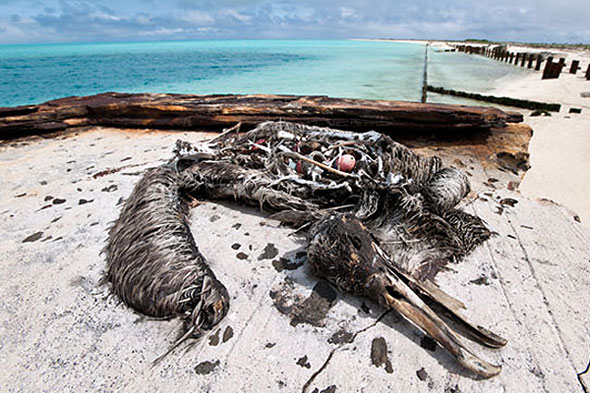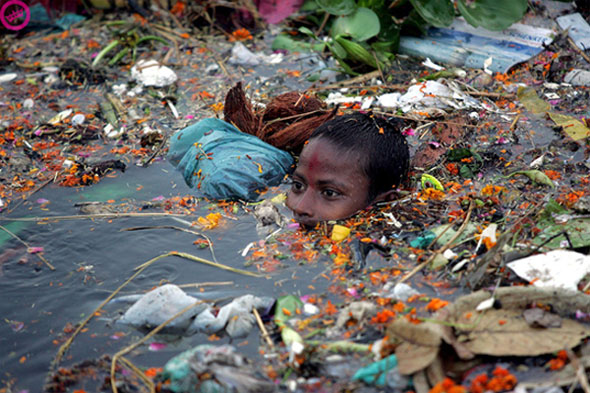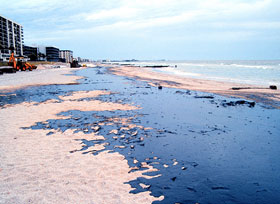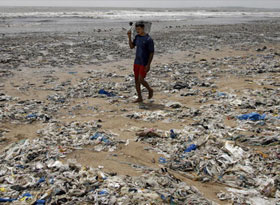Contents
Plastic Pollution
When The Mermaids Cry: The Great Plastic Tide
by Claire Le Guern
The world population is living, working, vacationing, increasingly conglomerating along the coasts, and standing on the front row of the greatest, most unprecedented, plastic waste tide ever faced.
Washed out on our coasts in obvious and clearly visible form, the plastic debris spectacle blatantly unveiling on our beaches is only the prelude of the greater story that unfolded further away in the the world’s oceans, yet mostly originating from where we stand: the land.
In 2008, our global plastic consumption worldwide has been estimated at 260 million tons. Plastic is versatile, lightweight, flexible, moisture resistant, strong, and relatively inexpensive. Those are the attractive qualities that lead us, around the world, to such a voracious appetite and over-consumption of plastic goods. However, durable and very slow to degrade, plastic materials that are used in the production of so many products all, ultimately, become waste with staying power. Our tremendous attraction to plastic, coupled with an undeniable behavioral propensity of increasingly over-consuming, discarding, littering and thus polluting, has become a combination of lethal nature.

African coast marine debris. Photo: Candace Feit
A simple walk on any beach, anywhere, and the plastic waste spectacle is present. All over the world the statistics are ever growing, staggeringly. Tons and tons of plastic debris (which by definition are waste that can vary in size from large containers, fishing nets to microscopic plastic pellets or even particles) is discarded every year, everywhere, polluting lands, rivers, coasts, beaches, and oceans. Last year, an estimated 150,000 tons of marine plastic debris ended up on the shores of Japan and 300 tons a day on India’s coasts.>
Lying halfway between Asia and North America, north of the Hawaiian archipelago, and surrounded by water for thousands of miles on all sides, the Midway Atoll is about as remote as a place can get. However, Midways’ isolation has not spared it from the great plastic tide either, receiving massive quantities of plastic debris, shot out from the North Pacific circular motion of currents (gyre). Midways’ beaches, covered with large debris and millions of plastic particles in place of the sand, are suffocating, envenomed by the slow plastic poison continuously washing ashore.
Then, on shore, the spectacle becomes even more poignant, as thousands of bird corpses rest on these beaches, piles of colorful plastic remaining where there stomachs had been. In some cases, the skeleton had entirely biodegraded; yet the stomach-size plastic piles are still present, intact. Witnesses have watched in horror seabirds choosing plastic pieces, red, pink, brown and blue, because of their similarity to their own food. It is estimated that of the 1.5 million Laysan Albatrosses which inhabit Midway, all of them have plastic in their digestive system; for one third of the chicks, the plastic blockage is deadly, coining Midway Atoll as “albatross graveyards” by five media artists, led by photographer Chris Jordan, who recently filmed and photographed the catastrophic effects of the plastic tide there.

Albatross, victim of plastic ingestion. Photo: Unknown.
From the whale, sea lions, and birds to the microscopic organisms called zooplankton, plastic has been, and is, greatly affecting marine life on shore and off shore. In a 2006 report, Plastic Debris in the World’s Oceans, Greenpeace stated that at least 267 different animal species are known to have suffered from entanglement and ingestion of plastic debris. According to the National Oceanographic and Atmospheric Administration, plastic debris kills an estimated 100,000 marine mammals annually, as well as millions of birds and fishes.
The United Nations Joint Group of Experts on the Scientific Aspects of Marine Pollution (GESAMP), estimated that land-based sources account for up to 80 percent of the world’s marine pollution, 60 to 95 percent of the waste being plastics debris.
However, most of the littered plastic waste worldwide ultimately ends up at sea. Swirled by currents, plastic litter accumulates over time at the center of major ocean vortices forming “garbage patches”, i.e. larges masses of ever-accumulating floating debris fields across the seas. The most well known of these “garbage patches” is the Great North Pacific Garbage Patch, discovered and brought to media and public attention in 1997 by Captain Charles Moore. Yet some others large garbage patches are highly expected to be discovered elsewhere, as we’ll see further.
The plastic waste tide we are faced with is not only obvious for us to clearly see washed up on shore or bobbing at sea. Most disconcertingly, the overwhelming amount and mass of marine plastic debris is beyond visual, made of microscopic range fragmented plastic debris that cannot be just scooped out of the ocean.
Slow, silent, omnipresent, ever increasing, more toxic than previously thought, the plastic debris’ reality bears sobering consequences, as recently unveiled by the report of Japanese chemist Katsuhiko Saido at the 238th National Meeting of the American Chemical Society (ACS) in August 2009 and the findings from the Project Kaisei and Scripps (Seaplex) scientific cruise-expeditions collecting seawater samples from the Great Garbage Patch. Both, the reports and expeditions uncovered new evidence of how vast and “surprisingly” (as it was termed at the ACS meeting) toxic the plastic presence in the marine environment is.
Environmentalists have long denounced plastic as a long-lasting pollutant that does not fully break down, in other terms, not biodegradable. In 2004, a study lead by Dr Richard Thompson at the University of Plymouth, UK, reported finding great amount of plastic particles on beaches and waters in Europe, the Americas, Australia, Africa and Antarctica. They reported that small plastic pellets called “mermaids tears”, which are the result of industry and domestic plastic waste, have indeed spread across the world’s seas. Some plastic pellets had fragmented to particles thinner than the diameter of a human hair. But while some cannot be seen, those pieces are still there and are still plastic. They are not absorbed into the natural system, they just float around within it, and ultimately are ingested by marine animals and zooplankton (Plankton that consists of tiny animals, such as rotifers, copepods, and krill, larger animals eggs and larvae’s and of microorganisms once classified as animals, such as dinoflagellates and other protozoans.). This plastic micro-pollution, with its inherent toxicity and consequences on the food chain, had yet to be studied…
Dr Saido’s study was the first one to look at what actually happens over the years to these tons of plastic waste floating in the world’s oceans. The study presents an alarming fact: these tons of plastic waste reputed to be virtually indestructible, do decompose with surprising speed, at much lower temperature than previously thought possible, and release toxic substances into the seawater, namely bisphenol A (BPA) and PS oligomer. These chemicals are considered toxic and can be metabolized subsequent to ingestion, leading Dr Saido to state “…plastics in the ocean will certainly give rise to new sources of global contaminations that will persist long into the future”.
This past August a different study, from a group of oceanography students from Scripps Institution of Oceanography (SIO), UCSD, accompanied by the international organization Project Kaisei’s team, embarked on two vessels, New Horizon and Kaisei, through the North Pacific Ocean to sample plastic debris and garbage. SIO director Tony Haymet described the trip as “ …a forage into the great plastic garbage patch in the north.” To summarize the scientific data collected on the ship, Miriam Goldstein, chief scientist on New Horizon, stated: “We did find debris… coming up in our nets in over 100 consecutive net tows over a distance of 1,700 miles… It is pretty shocking.” She said, “[There is] not a big island, not a garbage dump [that we] can really see easily.” She described it more as a place where large debris floats by a ship only occasionally, but a lot of tiny pieces of plastic exist below the surface of the water. “Ocean pretty much looks like ocean,” she said. “The plastic fragments are mostly less than a quarter inch long and are below the surface. It took at first a magnifying-glass to see the true extent of plastic damage in the North Pacific.”
The overwhelmingly largest unquantifiable plastic mass is just made of confetti-like fragmented pieces of plastic.
In a press conference in September 2009, the director of the California Department of Toxic Substances Control (DTSC), Maziar Movassaghi, referring to Project Kaisei’s findings, held a small glass bottle filled with seawater sampled at the Great North Garbage Patch. Inside was murky seawater with hundreds of fragmented plastics pieces: “That is what we have to stop”.
All sea creatures, from the largest to the microscopic organisms, are, at one point or another, swallowing the seawater soup instilled with toxic chemicals from plastic decomposition. The world population “… (is) eating fish that have eaten other fish, which have eaten toxin-saturated plastics. In essence, humans are eating their own waste.” (Dixit Renee Brown, WiredPress).

Photo: Manan Vastsyayana
The scientists from Project Kaisei and Scripps hope their data gives clues as to the density and extent of these debris, especially since the Great Pacific Garbage Patch might have company in the Southern Hemisphere, where scientists say the gyre is four times bigger.” We’re afraid at what we’re going to find in the South Gyre, but we’ve got to go there,” said Tony Haymet.
The “Silent World” is shedding mermaid tears. A plastic-poison has undeniably been instilled by us, prompting an unwilling and illegitimate confrontation of two titans: one synthetic (plastic), the other oceanic. The crisis is of massive proportion. An unprecedented plastic tide has occurred, pervasively affecting the world’s oceans, beaches, coasts, seafloor, animals and ultimately, us.
Read more, See more… When The Mermaids Cry | Full Dossier
Oil Pollution
Oil spills on the worlds beaches and in the worlds oceans
by Linda Pilkey-Jarvis
Beaches and river shorelines all over the world are at risk from oil spills. Spills are most likely to occur while oil is transported or transferred between oil tankers, barges, pipelines, refineries, and distribution or storage facilities. Spills may also occur during natural disasters (such as hurricanes), or through deliberate acts by countries at war, sunken ships, vandals, or illegal dumpers.
Risk and Prevention
Oil spill risk is a function of consequence and probability. Spills from tankers for example may have a low probability of occurring due to efforts to prevent spills, but are high consequence events when they do occur because of the type of oil and huge volume that could be spilled. By contrast, spills from oil terminals may occur more frequently (high probability), but may be low consequence events because of the smaller volume being stored or transferred.
Oil spill risk changes over time. Today, tank ships are constructed with double hulls to reduce the risk, while they are built to carry larger and larger volumes of oil. In other words the beach disaster is less likely but if it occurs it will be larger. Eco-tourism takes vessels into formerly remote areas of the world, such as the Antarctic. Around the world our pipelines are aging yet are becoming a larger source for oil movement. In certain areas our oceans, especially in the South Pacific, sunken ships from past wars are beginning to lose their integrity and release oil. The intensity of storms around the world is changing and the threat to our offshore drilling facilities is increasing. An unknown amount of oil was released throughout Hurricane Ike in September of 2008 as it struck Galveston Island in the United States.
An ounce of prevention is worth a pound of cure for our precious and valuable marine environments. Preventing all spills may not be an attainable goal but prevention can certainly reduce the frequency and severity of spills. Prevention activities include thorough training of people, proper Equipment Maintenance, Adequate Staffing And Limiting Work Hours, Internal And Independent Auditing Of Oil Practices, Company Policies And Cultures That Focus On Prevention.
Planning for Aggressive and Effective Response to Spills
Spills cannot entirely be prevented so the second line of defense is preparing for the possibility. This means developing an active “culture of preparedness” for continuous improvement and initiative rather than reaction. Preparedness perfects response and fights complacency.
Preparedness includes:
- Requirements to report spills to government agencies.
- Developing oil spill plans.
- Pre-staging equipment and training professional response personnel.
- Drills to test the plans and then uses lessons learned to strengthen the plans.
- Computer modeling to understand trajectories of spoiled oil, fate & effect in the environment.
Involving beach communities in planning is important. Sometime tradeoffs have to be considered. The concept of balancing environmental risk and sensitivities against socio-economic factors (e.g. fisheries, tourism) in order to determine the most appropriate techniques and level of cleanliness (sometimes referred to as “net environmental benefit analysis”) is well known and widely accepted.
Type of Oil
One of the most significant factors in any spill is the type of oil spilled, especially its probable persistence on the beach and in the marine environment. Non-persistent oils include light refined products (e.g. gasoline) which are highly volatile materials with low viscosities. These oils tend to evaporate rapidly and because of the ease with which they disperse and dissipate naturally there is usually only a limited requirement for cleanup. Such oils may, however, pose a significant fire and explosion hazard as well as cause public health concerns if they occur close to crowded beaches or other places where people gather. They may also cause significant environmental impacts due to their high concentration of toxic components but, as these same components evaporate rapidly, any such effects will usually be highly localized.
At the other end of the spectrum of oil types are heavy crudes and heavy fuel oils. These oils are highly persistent when spilled due to their greater proportion of non-volatile components and high viscosity.
Biofuel Oils: Biofuel based oils are gaining in use and demand. Many non-petroleum oils have similar physical properties as petroleum based oil, their solubility in water is limited, they both create slicks on the surface of water, and they both form emulsions and sludge. In addition, non-petroleum oils tend to be persistent, remaining in the environment for long periods of time.
Fate and Effect of Spilled Oil
Oil floats on water and very heavy oil can sometimes sink making it hard to collect. Oil spreads out rapidly across the water surface to form a thin layer called l an oil slick. In its thinnest form, it is called a sheen (often seen as rainbow colored).
At the same time as it moves and fragments, it also undergoes physical and chemical changes, collectively termed weathering. Most of these weathering processes, such as evaporation, dispersion, dissolution and sedimentation, lead to the disappearance of oil from the sea surface. On the other hand, the formation of water-in-oil emulsions (“mousse”) and the accompanying increase in viscosity as the oil absorbs up to four times its own volume of water, promote the oil’s persistence. Oil can form emulsions or end up as tar balls and pats on shorelines or travel long distances at sea.
Large oil spills can be very harmful to birds and marine mammals, fish and shellfish and all sorts of natural, cultural and economic resources. However, even a smaller spill may prove much more harmful than a larger spill if it occurs at the wrong time or season and in a sensitive environment.
Response Techniques
People may use any of the following kinds of tools to clean up or minimize impacts from spilled oil:
- Mechanical recovery using booms, which are floating barriers to oil (for example, a big boom may be placed around a tanker that is leaking oil, to collect the oil or around sensitive areas to deflect the oil).
- On-water recovery using skimmers, which are used on boats to remove spilled oil from the water surface. Skimmers can also work from vacuum trucks, which can vacuum spilled oil off of beaches or the water surface.
- Sorbents, which are natural or synthetic materials used to absorb oil.
- Chemical dispersants and biological agents, which break down the oil into its chemical constituents but this may add pollutants to the sea floor.
- In-situ burning, which is a method of burning freshly-spilled oil, usually while it’s floating on the water.
- Washing oil off beaches with either high-pressure or low-pressure hoses. Or shovels and road equipment, which are sometimes used to pick up oil or move oiled beach sand and gravel down to where it can be cleaned by being tumbled around in the waves.
- Deterrence or scare tactics to keep wildlife from the spill area and Wildlife Rehabilitation stations where oiled wildlife can be rescued and cleaned.
- No response. Sometimes, people may decide not to response at all to a spill, because in some cases, responding isn’t helpful or even adds to the damage from the spill.
Determining How to Remove Oil from Beaches
There is a standardized survey technique called Shoreline Cleanup and Assessment Teams (SCAT) used around the world. The basic concepts of a SCAT survey are:
- a systematic assessment of all shorelines in the affected area,
- a division of the coast into geographic units or “segments” and,
- a set of standard terms and definitions and documentation.
Cleanup techniques depend on the type of beach, degree of exposure to waves and currents, and biological sensitivity. Learn more.
Things you can do to prevent future wars for oil:
- Reduce energy use
- Drive slower.
- Accelerate slower
- Buy local
- Drink tap water, not water in oil based bottles
- Bike and walk when possible
- Carpool
- Resist impulse buying
- Take care of power equipment
- Use manual tools when possible
- Use energy efficient lighting
- In the winter, wear a sweater around the house
Oil Spill Resources
- View our exclusive database of large oil spills.
- View a map of major world oil spills featured on the Greenpeace web site.
Trash Pollution
Trash pollution and contamination of beaches and nearshore waters is a global problem. In the United States in 2006, water samples from 92 beaches in 19 different states exceeded public health standards for pollutants. Offshore sewer outfalls, faulty (or non-existent) septic systems, non-point source agricultural run-off and increased sedimentation from logging and agriculture are common problems. Recently, beach nourishment (pumping sand onto the beach) has become a major source of fine sediment pollution (southern Spain, southeast Florida), causing harm to many nearshore ecosystems, particularly hard grounds and reef. Discarded trash can become a component of nonpoint source pollution runoff. Plastics, metals and other types of trash often harm animals and plants. Plastics and metals degrade very slowly over time and can leach harmful chemicals into the environment. These materials can also contribute to the transmission of disease. In addition, trash simply degrades the beauty of an area.
Runoff is also a major problem. Urban areas with large numbers of automobiles, trucks, and large transportation systems are major sources of oil based pollution into soils and paved surfaces. Rain washes surface pollutants to streams where they eventually course towards the oceans. Degraded water quality affects coastal ecosystems.
Beach Pollution Resources
- E. coli Thrives in Beach Sands, from Live Science, June 24, 2007
- Check out The Manual of Emergency Responses for Spills made by NOAA.
- View more photos of Beach Pollution.


